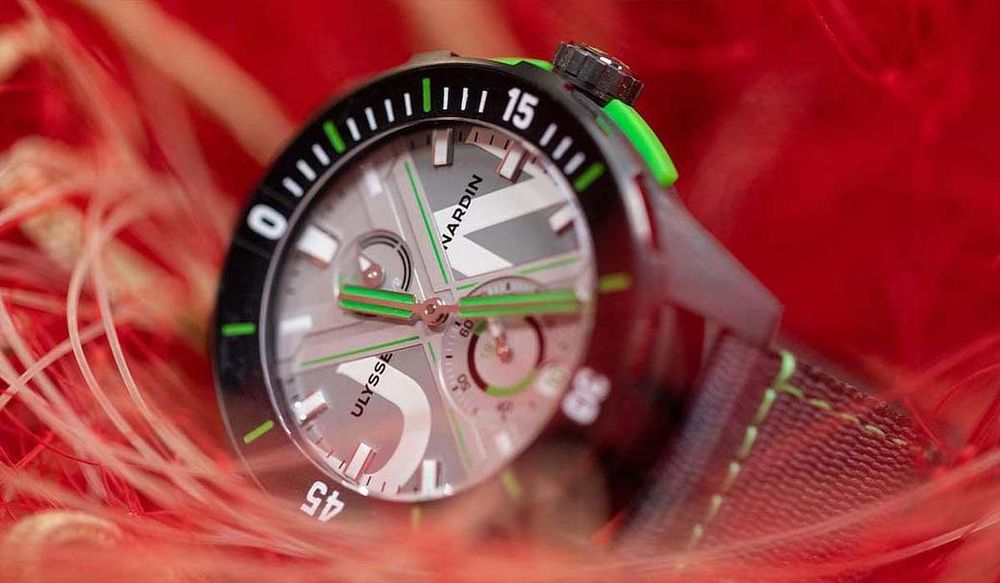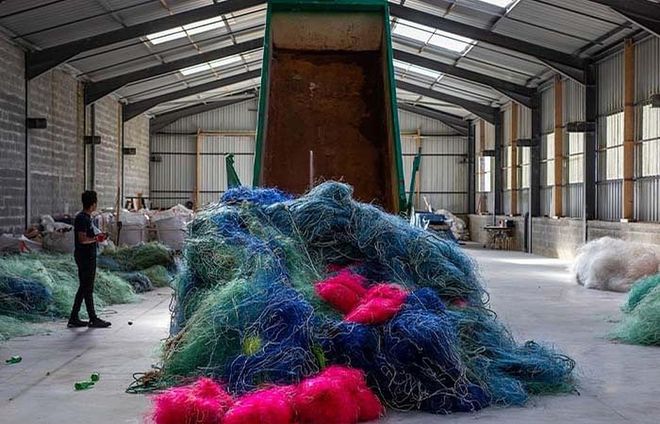Eco-Friendly Watches Take The Stage
Will collectors buy into this new movement in watchmaking?

While new luxury timepieces commanded the limelight at this year’s Watches and Wonders mega online affair in April, another movement was unfolding in tandem – that of major brands rolling out their own lines of eco-friendly watches.
Among the notable names jumping on the sustainability bandwagon are Cartier, Panerai and Ulysse Nardin, which unveiled timepieces made from recycled materials and powered by renewable energy sources. Cartier, for one, launched a new Tank Must line of watches with a strap that’s nearly half vegetable waste and a movement running on solar power.
“With this watch (collection), we intend to further reduce the Maison’s environmental footprint over its entire life cycle as part of our journey towards making a durable positive impact through our activities,” says Cartier’s international marketing and communications director Arnaud Carrez in an e-mail response.
Related article: A Pro-Level Guide To Buying Pre-Owned And Vintage Watches

Arnaud Carrez, Cartier's international marketing and communications director (Photo: Cartier)
However, are customers embracing the move towards ‘green’ watches? None of the brands say they were pushed by consumer demand, at least not directly. Instead, Ulysse Nardin believes it is anticipating tomorrow’s needs.
“We believe only socially conscious brands have a future in today’s economy,” says its chief executive Patrick Pruniaux. “You can’t ignore that younger generations are now more conscious of the environmental and social impact of their purchases. Any eco-friendly steps, even small ones, are still steps for our brand and for the planet.”
Related article: Sustainable Loungewear Label NOST Celebrates Heritage Crafts Through Innovation
It’s “desirable from a societal perspective”, he adds. “The entire luxury industry is a guiding force. We should be an example for everyone.”
Officine Panerai’s product development director, Alessandro Ficarelli, chips in: “We’re now at a turning point . . . We all have to develop projects and ad hoc activities to protect the environment.”
Panerai’s two new sustainable timepieces, the Submersible eLab-ID and Luminor Marina eSteel, reflect a commitment to embrace sustainability and to raise the watchmaking community’s awareness of climate change.
“It highlights our move in this direction – to show that it’s possible to use recycled and sustainable materials, reducing the need for virgin material extraction”, says Mr Ficarelli. The two watches boast almost 100 per cent recycled materials by weight.
Related article: Investment-Worthy Cartier Designs That Stand The Test Of Time

Recycled fishing nets that Ulysse Nardin uses for making parts of a watch, like the bezel. (Photo: Ulysse Nardin)
The brand is already working on “an open source project” to share its best practices in sustainability and support those keen to adopt them.
Proof of consumer appetite for sustainably produced watches has been mixed. Some buyers say because watches are luxury goods, not necessities, their production should have a strong focus on sustainability.
Still, when presented with a watch brand built around it, they apparently failed to respond. The Richemont Group, which owns Panerai, introduced Baume in 2018 as an online-only business based on sustainability and customisation. Two years later, it was absorbed into Baume et Mercier – another Richemont brand.
Related article: 8 Timepieces Under S$10,000 Worth The Investment
It’s estimated that Baume sold just 1,500 watches at US$500 to US$1,500. Was the price point too high for the targeted young customers? Do they want to pay a premium for sustainability?
Green supporters say sustainability isn’t something that is a bonus to them. “They expect it; it’s not a reward,” one argues.
The beginning of a wave
While there may be very few “Gretas”, they’re very vocal, observes Erwan Rambourg, the global co-head of consumer and retail research at HSBC, referring to the climate activist Greta Thunberg. “Few customers are asking for this but they’re the youngest and loudest. So either you hope it passes, or you start to invest because those few vocal consumers today are the beginning of a wave.”
Christoph Grainer-Herr, IWC’s chief executive, was quoted in a recent New York Times article that going green is a way to future-proof IWC’s business. “The impression you make (now) on a younger consumer is fundamentally important to build the right image and hopefully that will pay off in years to come.”
Related article: Take A Walk On The Wild Side With These 5 Animal-Inspired Watch Dials
The World Wildlife Fund, the leading international conservation body, in 2018 gave IWC the highest environmental rating among watch brands.
Cartier, which got the second highest rating, says innovation is rooted in the brand’s DNA and it sees sustainability as “responsible innovation” that serves to improve its production and products as well as “to reduce its environmental impact as much as possible”.
Because of the underlying expectations, sustainability may never be the first consideration in a luxury watch purchase. “I don’t think people buy a watch because it’s environmentally friendly; they buy (it) because it’s a great product,” says Ulysse Nardin’s Mr Pruniaux.
Yet, whether customers really care or not, more brands today are touting their green credentials. “People in sales didn’t have the responsibility question three years ago and now they do,” HSBC’s Mr Rambourg says.
Three years ago, the watch industry – based largely in Switzerland – was generally indifferent to the impact it had on the environment, according to the WWF. In a report released in 2018, it skewered the watch business for being ignorant of where its raw materials come from.
“If a company does not know where its raw materials are coming from, it might be (unintentionally) supporting tropical deforestation, violent conflicts, illegal trade, child labour, immense health hazards and numerous other effects,” the report says.
It points out that the industry consumes over half of the world’s gold production yearly and accounted for much of gold mining activity, which is harmful to the environment.
Noting that the report’s findings are “highly worrying and prove it is time for change”, the WWF urges improvement in areas like exercising due diligence in sourcing, managing supply chains responsibly and sustainably as well as providing transparency and communication in its efforts at sustainability.
Ironically, a high-quality mechanical watch is considered to be a sustainable product. After all, the argument goes, longevity is one of the paramount virtues of traditional watchmaking, and designed to last for generations.
Patek Philippe’s memorable slogan, “You never actually own a Patek Philippe – you merely take care of it for the next generation”, is more than just clever marketing. A glance at the catalogues of major auction houses reveals the long life cycles of high-quality timepieces.
“A mechanical watch has no expiration date,” says Ulysse Nardin’s Mr Pruniaux. “We are naturally sustainable.”
Still, the watch brands have little to say on the WWF report. Some, such as Chopard and IWC, were mindful of the environment long before they read it.

Chopard's LUC Flying T Twin, a flying tourbillion with an ultra-thin case in ethically certified 'Fairmined' rose gold. (Photo: Chopard)
Chopard was one of the first to focus on gold supplies in 2010. In 2013, it partnered Eco-Age, a sustainable luxury consultancy firm, to work on the responsible sourcing of gold. Chopard is also working with the Alliance for Responsible Mining to support and help mining communities obtain the ethical Fairmined Gold certification.
In 2018, Chopard committed to using 100 per cent “ethical gold” in its jewellery and watch creations, a move the WWF says is a key step for the industry. Ethical gold is acquired from responsible sources that meet international best practices in sustainability efforts.
Among the first movers in the industry
IWC is one of the first movers in the industry when it comes to promoting climate awareness. It harnesses electrical energy from 100 per cent renewable sources. Many features of contemporary climate-efficient architecture are built into its manufacturing centre, which opened in 2018.
IWC, the only watch brand to publish its own sustainability report, has earned respect for its governance structure and policies, due diligence when working with suppliers, enforcement of environmental standards in its supply chain, and setting of goals for greenhouse gas emissions.
Panerai is operating a 100 per cent eco-friendly factory as well and has ambitious plans mapped out to achieve a higher level of sustainability for its products.
Ulysse Nardin is aiming for complete transparency while working on other green innovations. “We’ve a list of projects – it’s an Excel file with so many lines – and we’re talking all of it, and it goes from the packaging to the end consumer,” says Mr Pruniaux.
More watch brands now are jumping in on the sustainability journey – and about time they do. “If a company only acts when its own products or business practices are being criticised or directly affected, it can no longer create trust,” the WWF warns.
This article was originally published in The Business Times.